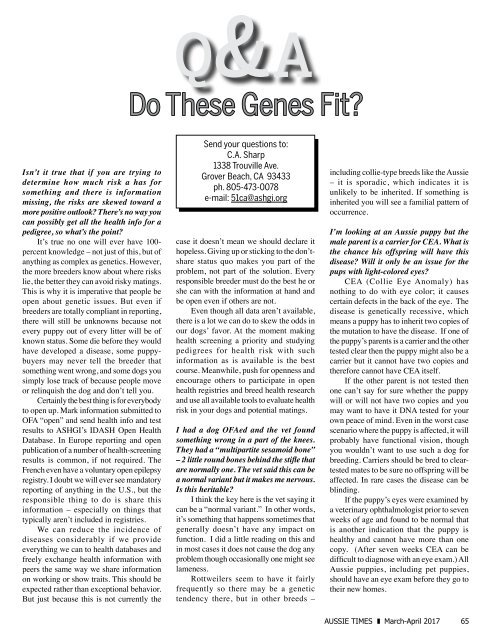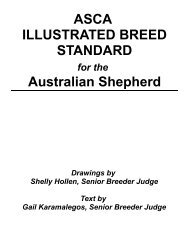You also want an ePaper? Increase the reach of your titles
YUMPU automatically turns print PDFs into web optimized ePapers that Google loves.
Q&A<br />
Do These Genes Fit?<br />
Isn’t it true that if you are trying to<br />
determine how much risk a has for<br />
something and there is information<br />
missing, the risks are skewed toward a<br />
more positive outlook? There’s no way you<br />
can possibly get all the health info for a<br />
pedigree, so what’s the point?<br />
It’s true no one will ever have 100-<br />
percent knowledge – not just of this, but of<br />
anything as complex as genetics. However,<br />
the more breeders know about where risks<br />
lie, the better they can avoid risky matings.<br />
This is why it is imperative that people be<br />
open about genetic issues. But even if<br />
breeders are totally compliant in reporting,<br />
there will still be unknowns because not<br />
every puppy out of every litter will be of<br />
known status. Some die before they would<br />
have developed a disease, some puppybuyers<br />
may never tell the breeder that<br />
something went wrong, and some dogs you<br />
simply lose track of because people move<br />
or relinquish the dog and don’t tell you.<br />
Certainly the best thing is for everybody<br />
to open up. Mark information submitted to<br />
OFA “open” and send health info and test<br />
results to ASHGI’s IDASH Open Health<br />
Database. In Europe reporting and open<br />
publication of a number of health-screening<br />
results is common, if not required. The<br />
French even have a voluntary open epilepsy<br />
registry. I doubt we will ever see mandatory<br />
reporting of anything in the U.S., but the<br />
responsible thing to do is share this<br />
information – especially on things that<br />
typically aren’t included in registries.<br />
We can reduce the incidence of<br />
diseases considerably if we provide<br />
everything we can to health databases and<br />
freely exchange health information with<br />
peers the same way we share information<br />
on working or show traits. This should be<br />
expected rather than exceptional behavior.<br />
But just because this is not currently the<br />
Send your questions to:<br />
C.A. Sharp<br />
1338 Trouville Ave.<br />
Grover Beach, CA 93433<br />
ph. 805-473-0078<br />
e-mail: 51ca@ashgi.org<br />
case it doesn’t mean we should declare it<br />
hopeless. Giving up or sticking to the don’tshare<br />
status quo makes you part of the<br />
problem, not part of the solution. Every<br />
responsible breeder must do the best he or<br />
she can with the information at hand and<br />
be open even if others are not.<br />
Even though all data aren’t available,<br />
there is a lot we can do to skew the odds in<br />
our dogs’ favor. At the moment making<br />
health screening a priority and studying<br />
pedigrees for health risk with such<br />
information as is available is the best<br />
course. Meanwhile, push for openness and<br />
encourage others to participate in open<br />
health registries and breed health research<br />
and use all available tools to evaluate health<br />
risk in your dogs and potential matings.<br />
I had a dog OFAed and the vet found<br />
something wrong in a part of the knees.<br />
They had a “multipartite sesamoid bone”<br />
– 2 little round bones behind the stifle that<br />
are normally one. The vet said this can be<br />
a normal variant but it makes me nervous.<br />
Is this heritable?<br />
I think the key here is the vet saying it<br />
can be a “normal variant.” In other words,<br />
it’s something that happens sometimes that<br />
generally doesn’t have any impact on<br />
function. I did a little reading on this and<br />
in most cases it does not cause the dog any<br />
problem though occasionally one might see<br />
lameness.<br />
Rottweilers seem to have it fairly<br />
frequently so there may be a genetic<br />
tendency there, but in other breeds –<br />
including collie-type breeds like the Aussie<br />
– it is sporadic, which indicates it is<br />
unlikely to be inherited. If something is<br />
inherited you will see a familial pattern of<br />
occurrence.<br />
I’m looking at an Aussie puppy but the<br />
male parent is a carrier for CEA. What is<br />
the chance his offspring will have this<br />
disease? Will it only be an issue for the<br />
pups with light-colored eyes?<br />
CEA (Collie Eye Anomaly) has<br />
nothing to do with eye color; it causes<br />
certain defects in the back of the eye. The<br />
disease is genetically recessive, which<br />
means a puppy has to inherit two copies of<br />
the mutation to have the disease. If one of<br />
the puppy’s parents is a carrier and the other<br />
tested clear then the puppy might also be a<br />
carrier but it cannot have two copies and<br />
therefore cannot have CEA itself.<br />
If the other parent is not tested then<br />
one can’t say for sure whether the puppy<br />
will or will not have two copies and you<br />
may want to have it DNA tested for your<br />
own peace of mind. Even in the worst case<br />
scenario where the puppy is affected, it will<br />
probably have functional vision, though<br />
you wouldn’t want to use such a dog for<br />
breeding. Carriers should be bred to cleartested<br />
mates to be sure no offspring will be<br />
affected. In rare cases the disease can be<br />
blinding.<br />
If the puppy’s eyes were examined by<br />
a veterinary ophthalmologist prior to seven<br />
weeks of age and found to be normal that<br />
is another indication that the puppy is<br />
healthy and cannot have more than one<br />
copy. (After seven weeks CEA can be<br />
difficult to diagnose with an eye exam.) All<br />
Aussie puppies, including pet puppies,<br />
should have an eye exam before they go to<br />
their new homes.<br />
AUSSIE TIMES <strong>March</strong>-<strong>April</strong> <strong>2017</strong> 65



